Archive for March, 2008
March 6, 2008 at 12:20 am · Filed under Travel / lifestyle musings
With a lot of time spent parked lately, and the prospect of three more weeks, we’ve had time to get new perspective on our travels. I know when we were heading here last December that I said it would be good to stop a while, but it’s getting ridiculous. We’ve been here for about eight weeks and it feels like longer.
Hey Universe! I’ve got perspective, really — can I go now?
I think we’ve crossed this country coast-to-coast about seven times in our Airstream. Every time we start another continental drive I always think, “This might be our last trip. Better make it a good one,” because we never truly know if we’ll get another chance. Even the first trip across (east to west), we thought we’d be at this for just six months and so we tried to see as much as we could before “the trip” ended.
The same is true today. We know we’ll go east and come back west, but beyond that my crystal ball is cloudy. So many things can happen that might sideline us for a long period of time. So as we head east I’m searching for new things to explore. We’ve never checked out Arkansas, and we’ve hardly spent any time in Tennessee. We’ve never been to North Dakota, hardly any of Minnesota, and there’s a lot of Idaho and eastern Washington I’d like to visit.
But we also want to visit friends and revisit some great spots. So I’m conflicted. If we stick to familiar places we might miss something (or someone) new and great. Somehow we’ve got to find a balance between the familiar and the novel. I stare at the road atlas again and again, waiting for the perfect route to pop up and announce itself.
People are asking if we’ll curtail our travels due to rising fuel prices. No, because really fuel is not a terribly expensive component of our travel. The trip to New England, via Florida, and back, will probably cost about $2,500-3,000 in fuel. Sounds like a lot, but keep in mind what we get for that:
- we can take our home with us, so no hotel rooms, no using the “spare bedroom”, and complete comfort at all times
- all the convenience that having everything with us entails, including Eleanor’s kitchen and my office
- unlimited nights on the road with very little added expense (most of the time we’ll be either courtesy parked or getting the monthly rate at a campground)
- incredible flexibility in scheduling; freedom to make changes of route or length of stay at any time without penalty
- much lower cost in food, because we can eat in our own kitchen instead of eating out.
What’s our alternative? Three airfares back to Vermont would cost about $900 and we’d be living out of suitcases, renting a car, and forced to a rigid, short schedule. No stops in Texas, Louisiana, Florida, or the Outer Banks either. No chance to visit friends all over the country. Bah. I’ll take the six-month tour in the Airstream instead, even at three times the cost. On a per-day basis, it’s still the cheapest traveling we’ll ever do.
But hey, maybe next year gas will be $15 a gallon. Maybe we’ll have some health problem that restricts our travel for a while. Who knows? We’ll have to take this trip like it really is our last, just in case.
So I’m planning. And re-planning. It has been a huge challenge to figure out a route, and I’m not done yet. The moving target deadline for the house hasn’t helped. Because of our later departure we may cut our planned service stop short, too, just getting the necessary stuff done and then moving on. Even as full-timers*, there’s never enough time to see and do all the things you want. This is a big country with over 300 million people in it, and 49 states you can drive to. I can’t imagine ever getting bored with exploring it, or with planning the next trip.
* We have been sleeping and cooking in the Airstream for the past eight weeks, so even though we are not moving, we’re still full-timers! (So there, Gadget!)
March 4, 2008 at 7:12 pm · Filed under Home base
You may have noticed me mentioning Bookmans in prior Tucson posts. It’s a small chain of used bookstores here and around Arizona. The chain is small, but the stores are large — about the size of an average Border’s or Barnes & Noble. And all the space is gloriously filled with used books of every imaginable description.
If you’re not a reader, this description may not give you palpitations, but for those who are, take your heart medicine. Bookmans is a true “find,” and two of their locations are practically in our back yard. In addition to the books they have fast and free wi-fi, cushy chairs, high ceilings, a spirited staff and an absolutely unpredictable selection of music playing constantly. It’s a public library on steroids. Open till 10 p.m. for those late-owl browsers. It’s a book nut’s idea of heaven.
No, it’s better than that. The people-watching alone is worth paying an admission fee. People who love books come in all sorts of shapes and sizes, and they are all parading past me as I sit here in my overstuffed floral-print chair taking notes. The staff is a hoot too. Their use of the public address system is creative, bordering on anarchic: “Jim … I’m up front … I’ve got that book you were looking for … but you’re not here … (fake sob) How could you do this to me?”
and later: “We’re going to change the music. Annie suggested something better. If you like it, thank her … and by the way, you can buy the CD for eight bucks.”
 I came here for the high speed Internet because I had a lot of major files to move around today, but I stayed because Bookmans makes the whole family happy. I get my work done faster, Emma gets to sit and read, and Eleanor shops for more books, games, and all kinds of other stuff they have, for cheap. From my chair — which I am not going to give up until my battery dies — I can see used CDs, game cartridges, DVDs, magazines, faux jewelry, and today a selection of funky vintage purses hanging on the rack.
I came here for the high speed Internet because I had a lot of major files to move around today, but I stayed because Bookmans makes the whole family happy. I get my work done faster, Emma gets to sit and read, and Eleanor shops for more books, games, and all kinds of other stuff they have, for cheap. From my chair — which I am not going to give up until my battery dies — I can see used CDs, game cartridges, DVDs, magazines, faux jewelry, and today a selection of funky vintage purses hanging on the rack.
Lately our flow of books has been in the reverse direction. We’ve now opened the ten or so cartons of books that survived the cut in Vermont (out of 30 or so cartons) and found that there were still more we didn’t care to keep any longer. So I brought over a box of books the other day and they bought about ten of them, giving me a $34 store credit. I’m sure that will be used up today for kids books, but that’s OK. Thirty-four bucks worth of used books should keep Emma occupied for at least a week … I hope.
Besides, once in while they surprise us here with a little bonus. A few weeks ago we were at the Oro Valley store and Emma picked out a book. The guy at checkout asked, “How old are you?” and Emma replied, “Seven!” He said, “Well today all 7-year-olds get their books for free,” and he refused any payment. When was the last time that happened to you at any store?
So here’s a vote for a very cool store that is one of the many reasons why we like Tucson.
March 3, 2008 at 6:46 pm · Filed under Uncategorized
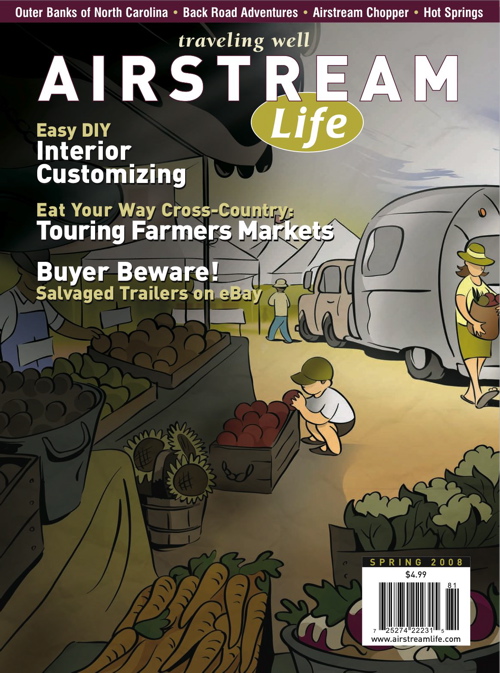 I’m going to wander off topic here today, because I need to get some things off my chest about the sad state of magazine publishing in this country.
I’m going to wander off topic here today, because I need to get some things off my chest about the sad state of magazine publishing in this country.
As you probably know, I publish Airstream Life magazine and have done so since 2004. Airstream Life is a magazine that, by conventional wisdom, shouldn’t exist. It serves far too small an audience, and attempts to do it with a level of quality that is far above a magazine with circulation of 12,000. Most full-color magazines, even quarterly ones, have circulation in the tens of thousands at the very least.
Honestly, Airstream Life would not exist if not for the Internet revolution. Virtual offices, easy electronic collaboration & document sharing, digital photography, digital layout & proofing, online marketing, and e-commerce are the essential technological elements of a business such as this. If I had to open a physical office and give everyone a desk and telephone, the magazine would never have launched. If we couldn’t market the magazine inexpensively via the Internet, we wouldn’t have many subscribers. In a dozen different ways, Airstream Life and other niche magazines — such as Atomic Ranch and Route 66 Magazine — are symbols of the efficiencies made possible by the Internet.
This is great not only because new technologies have enabled magazines to pop up that couldn’t exist before, but because these small magazines have to be of very high quality in order to survive in today’s competitive environment. The world is awash in magazines, and it is an extremely competitive business. Hundreds of new titles launch every year, and most of them die quickly. Magazines have to fight for advertisers and spots on newsstands, in a time when paper prices are rising as much as 20% per year, and as advertisers move their budgets from print magazines to other forms of marketing.
Remember the Avis rental car commercials of the 1960’s? “We’re number two. We try harder.” That’s the situation of niche magazines, except that we’re not number 2, we’re number 71,532. The media buyer at a national advertiser can go to a major RV magazine like Trailer Life and get 200,000 pairs of eyeballs with one ad, so how do we get them to advertise in tiny little Airstream Life?
We do it by being more focused and better than other RV magazines. In other words, we try to publish better articles, better photos, on better paper and with better customer service. We’re not perfect by any means, but we hustle and do our best. We do our homework. We take quality seriously. All of those things are appreciated by our subscribers. I know because they tell us. The other niche magazines do the same, or they earn a quick death.
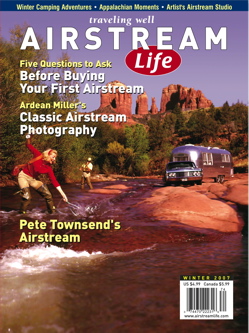 And that brings me to the inspiration for this little editorial. I read most of the competitive magazines in the RV segments, and let me tell you, there’s a lot of crap out there. Really. I’ve never called out my competition before but I just can’t stay silent any longer. Too many of the titles are publishing junk articles that are:
And that brings me to the inspiration for this little editorial. I read most of the competitive magazines in the RV segments, and let me tell you, there’s a lot of crap out there. Really. I’ve never called out my competition before but I just can’t stay silent any longer. Too many of the titles are publishing junk articles that are:
- poorly researched, just plain wrong, or misleading
- badly written, hopelessly vague or useless
- entirely and obviously pandering to an advertiser
- dumbed down to the point of being insulting
This problem exists to some extent across the magazine industry, but nowhere is it worse than in the RV segment. There seems to be a general malaise across the sector, and a feeling that low standards are good enough for the RV owner. Look at the selection available to an RV owner on the newsstand sometime. The editors seem stuck in the 1990s, and they seem to think their readers are exclusively people of low-brow interests and completely undiscerning of the pap they are receiving.
This is utterly wrong, and a huge disservice to the RV-owning audience of today. RV owners encompass all ages, all interests, and they aren’t just dumb yokels looking for cheap gas & flea markets. But read most of the magazines and you could be forgiven for making that assumption.
I finally hit my personal limit when I read an article on a visit to Yellowstone in an RV rag. Here are two excerpts:
“After arriving at Yellowstone, we stopped by the visitors center where we grabbed a sandwich, some ice cream, and oh yeah, some souvenirs. We were greeted by the picnic tables by a rather chubby chipmunk with whom our daughter delighted in sharing her Lay’s Potato Chips. A young cafeteria worker emerged happily from the visitor’s center and brought with him two whole-wheat crackers; he claimed they were the chipmunk’s favorite. I told him, ‘This one is eating some potato chips,’ to which he jokingly replied, ‘He might have a heart attack.’ “
… later in the same article …
“Before we left, I had tromped through brush, taken a photograph from our truck window of a grizzly bear less than five feet away, and had been ordered back to my vehicle by a park ranger with a bullhorn for getting too close to a mama black bear and her cub. My adrenaline had already warned me of the fact, but the park ranger wasn’t in the waving mood after that. As for me, I am now ready for a safari hat and the Serengeti.”
If this strikes you as intelligent, quality travel writing, then you probably won’t appreciate Airstream Life. (Hint: What’s the first thing they tell you about animals in a national park?)
But here’s the irony. You’d think with the generally low standards of RV publications, there’d be a strong demand for an intelligent, well-written and beautifully presented magazine that explores a more diverse range of topics than just tow vehicle comparisons and tips on how to feed Cheez Whiz to squirrels.
Sadly, the opposite is true. I’ve spoken to several well-placed consultants in the industry, and they all say the same things: you can’t make it on editorial quality alone. Circulation is king. Put out a sorry rag of a magazine, make it cheap so lots of people subscribe, and the advertisers will come. Don’t waste money on better articles because the advertisers don’t care. The media buyers don’t actually read the magazines, they just evaluate on the basis of CPM (ad cost per thousand readers).
This really hurts me because I won’t go that route, but it is a fact that no magazine can survive for long without ad revenue (or some other form of financial support beyond subscriptions). Subscriptions alone pay only a tiny fraction of the true cost of producing a magazine. If we had to charge what it really costs to produce Airstream Life, an annual subscription would be about $50 per year instead of $16.
I would like to think that there are advertisers who value quality. In fact, I know there are a few because they buy ads in our magazine. Those advertisers know that many Airstream Life readers save their issues, collect the back issues, and even buy them on eBay when they can. (Last month a copy of the inaugural issue — Summer 2004 — sold for $48 on eBay!) But those sorts of advertisers are far too scarce.
For three years we’ve been trying to convince media buyers that paying for quality really does result in a higher quality of customer. A few of them have figured that out, and they do really well. But we’ve never had an advertisement from any of the vehicle manufacturers, and we’ve been ignored by hundreds of other national advertisers with products and services aimed directly at the RV traveler.
Thus, the structure of the magazine industry reinforces and even encourages mediocrity. Bad magazines thrive on the strength of their circulation numbers, because that’s what media buyers think of first. They get that circulation by promoting subscriptions at ridiculously discounted rates (as low as $8 for 12 issues of a magazine like the one I quoted above — which barely covers the cost of the printing!), and the RV owner buys them because they are “a bargain,” thus perpetuating the cycle.
I can’t say that any of this is a surprise, but it does make survival a constant challenge. Despite the odds, we’ve been making a go of it by serving those folks who actually care about what they read, and hoping that eventually the advertisers — including the 70+ Airstream dealers who don’t currently advertise in Airstream Life — catch on.
In the meantime, the wonderful people who subscribe and tell me how much they love the magazine, continue to motivate me and all the other people who work on Airstream Life. Thank you. You’re the reason we’re doing this.
March 2, 2008 at 11:09 pm · Filed under Home base
Friends of ours from Nogales come up to Tucson every weekend to take advantage of the city’s offerings. (There’s not much to do in Nogales.) Since they’ve been here longer than we have, we asked to meet them in town to learn what sorts of places they like. They suggested lunch at the Hotel Congress, in the heart of downtown Tucson.
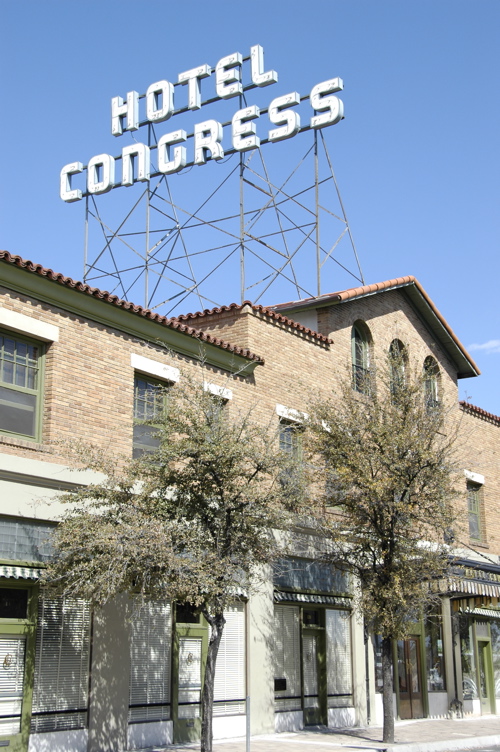
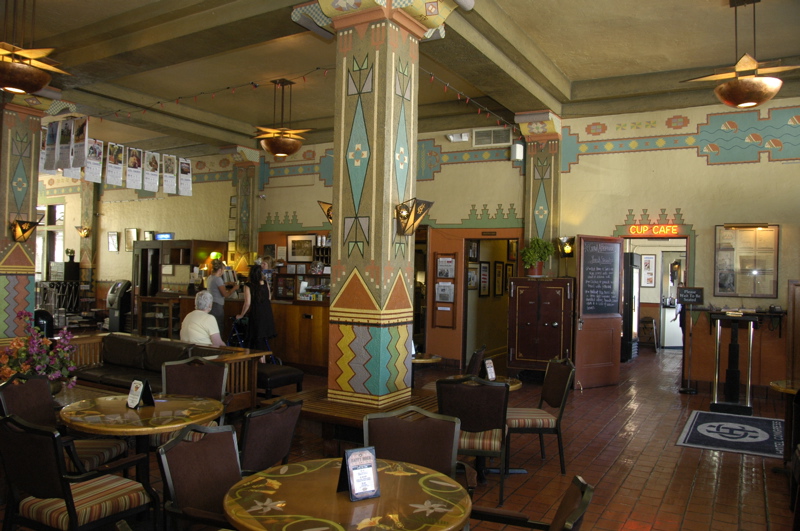
The Hotel Congress is a neat place. A fire on the third floor is famous for having flushed out John Dillinger in 1934, after a massive national manhunt failed to locate him and his gang. The hotel is still operating today, and is the kind of place I’d like to stay just to get a feel for the 1930s. The interior still feels appropriate to the period, with a few updates here and there. An old telephone switchboard is on display next to old telephone booths in the lobby which contain modern payphones. An old-time barber shop is still in operation off the lobby — I’d like to try it out.
Just off the lobby is a nightclub with frequent live entertainment, and another small pub. The overall sense I got was of an old Fred Harvey railroad hotel, probably because of the era and the use of native American designs throughout the interior. It’s very much like the way Mary Elizabeth Coulter would decorate, but the architecture doesn’t have her signature flair.
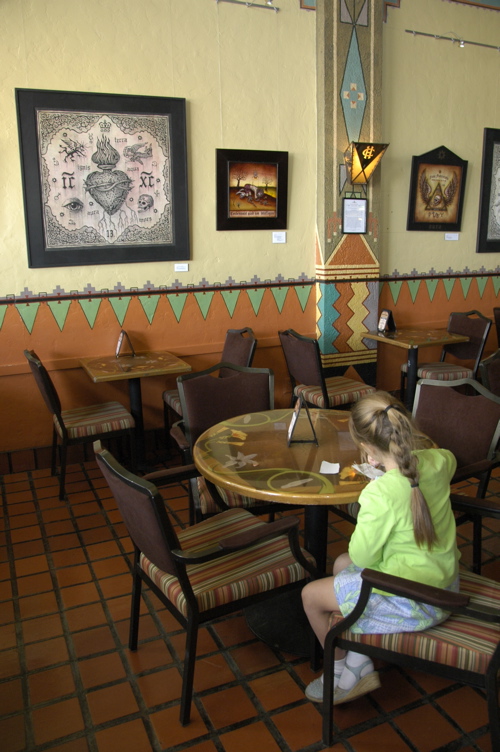 The lobby currently features art by Daniel Martin Diaz. Emma spotted one of his unusual designs and immediately had to try to copy it. She’s got a bit of talent for art that I completely lack, so I am always impressed when she does this and try to stand back long enough to let her complete it. Besides, there was enough of visual interest for me to stay busy taking pictures. I’ve set up a small album on Flickr of other images from the Hotel Congress here.
The lobby currently features art by Daniel Martin Diaz. Emma spotted one of his unusual designs and immediately had to try to copy it. She’s got a bit of talent for art that I completely lack, so I am always impressed when she does this and try to stand back long enough to let her complete it. Besides, there was enough of visual interest for me to stay busy taking pictures. I’ve set up a small album on Flickr of other images from the Hotel Congress here.
We ate lunch in the “Cup Cafe,” right off the lobby. It’s a fairly small place with perhaps a dozen tables and bar seating, and more tables outside. The floor is paved with pennies. Being in the middle of the downtown, it attracts a lively and funky crowd. Here’s the view I had during lunch …
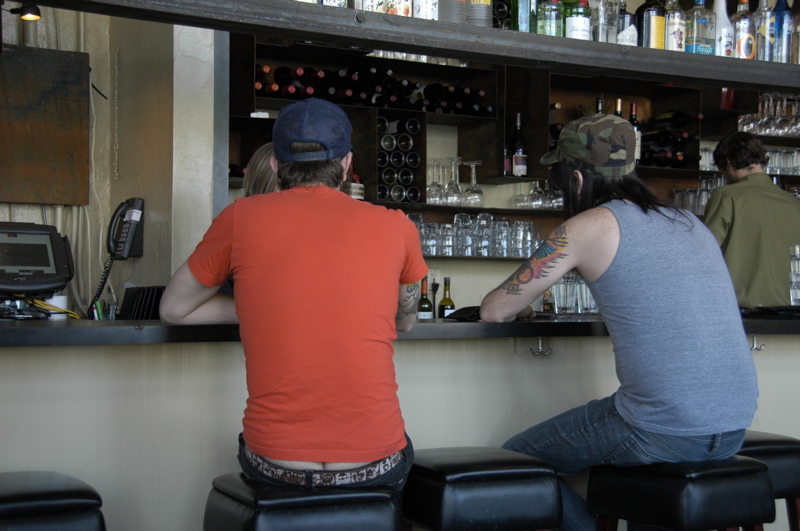
All through lunch I had to bite my tongue to avoid making, uh, wisecracks about the view. But if the view was less than appetizing, the lunch made up for it. Pretty darned good for a $9 lunch. We declined dessert, reluctantly, and headed out.
Being downtown made me realize how little of Tucson we’ve really had a chance to explore. There are so many cultural experiences, places, events, hikes, historic sites, and people to discover here. That’s a good thing, because I wouldn’t want to feel like I’d already “done everything” before we even finished the house! We are considering re-arranging our schedule yet again, to allow more time in Tucson. We’d do this by taking a week or two on the road in the Airstream in March and/or April, then returning to the house for a bit before heading out again for the summer. Nothing’s finalized, but it is clear that our plans are very fluid right now.
March 1, 2008 at 10:43 pm · Filed under Home base
OK, no Airstream philosophy or house angst or travel news today. This blog entry is strictly for those who are interested in our life “off the road.”
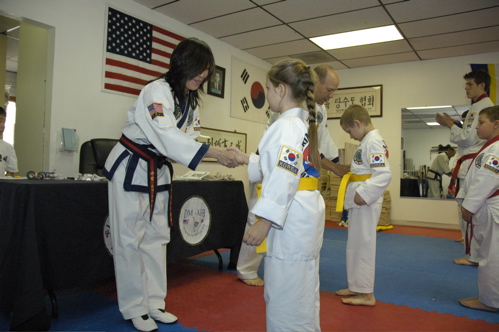 Emma has graduated to her yellow belt in karate class. Needless to say, it’s a very exciting day for her, and we’re happy she’s having fun and progressing. The test was comprised of an oral question (“Who is the founder of our karate school?”) which she answered correctly, a basic exercise involving all the moves the white belts have learned so far, and a ritual board-breaking.
Emma has graduated to her yellow belt in karate class. Needless to say, it’s a very exciting day for her, and we’re happy she’s having fun and progressing. The test was comprised of an oral question (“Who is the founder of our karate school?”) which she answered correctly, a basic exercise involving all the moves the white belts have learned so far, and a ritual board-breaking.
The school has boards of various difficulty for the students, which allows even the beginners to break a board the first time they test. The broken board makes an interesting souvenir for the day and, according to one father, pretty decent firewood too.
 Being stationary means we can do this sort of thing, but I have to admit I am chafing under the restriction of a three-times-a-week schedule. To go anywhere means we’d have to miss classes, which we haven’t wanted to do. In a week the sessions we paid for will run out, and since we are so close now to our departure date (I hope), we aren’t going to renew right now.
Being stationary means we can do this sort of thing, but I have to admit I am chafing under the restriction of a three-times-a-week schedule. To go anywhere means we’d have to miss classes, which we haven’t wanted to do. In a week the sessions we paid for will run out, and since we are so close now to our departure date (I hope), we aren’t going to renew right now.
We’ll start again in the fall, when we’re back in town. Emma now seems to be completely hooked on karate. Fair warning to Uncle Steve, Gunny, and others who would cross her path — this girl is ready on defense!
On the house front, we are a few steps closer. The couch arrived today (large and comfortable) and also our mattresses. We now have two fully functioning bedrooms and a living room to our credit. A number of smaller “punch list” items got dealt with as well, including drywall repairs, electrical connections for the kitchen appliances, and the last few pieces of baseboard. A lot of minor items are still on the list, but the big projects include installing kitchen countertops & appliances, fixing the leaking shower plumbing, and installing the sinks. Anything else that needs doing is not worth delaying our travels for, so we won’t sweat the small stuff.
« Previous entries










